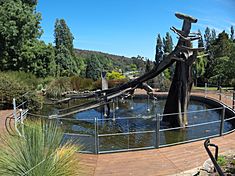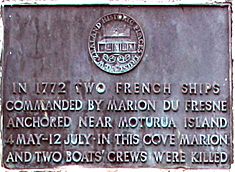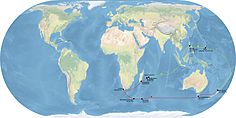Marc-Joseph Marion du Fresne facts for kids
Quick facts for kids
Marc-Joseph Marion du Fresne aka Marion Dufresne
|
|
|---|---|
| Born | 22 May 1724 St Malo, France
|
| Died | 12 June 1772 (aged 48) Assassination Cove, Bay of Islands, New Zealand
|
| Cause of death | Murder |
| Nationality | French |
| Occupation | Explorer, navigator, cartographer |
| Title | Capitaine de frégate |
| Spouse(s) | Julie Bernardine Guilmaut de Beaulieu |
Marc-Joseph Marion du Fresne (22 May 1724 – 12 June 1772), with the surname sometimes spelt Dufresne, was a French privateer and explorer. The expedition he led to find the hypothetical Terra Australis in 1771 made important geographic discoveries in the south Indian Ocean and anthropological discoveries in Tasmania and New Zealand. In New Zealand they spent longer living on shore than any previous European expedition. Half way through the expeditions stay du Fresne was murdered by members of the Ngare Raumati tribe.
He is commemorated in various place names, as well as in the name of the research vessel providing logistical support to the French Southern Territories of Île Amsterdam, Île Saint-Paul, Îles Crozet, and Îles Kerguelen, the Marion Dufresne II.
Contents
Early career
Du Fresne was born in Saint Malo in 1724 and joined the French East India Company at the age of 11 as a sub-lieutenant aboard the Duc de Bourgogne.
During the War of the Austrian Succession he commanded several ships as a privateer, including the Prince de Conty where he transported Charles Edward Stuart from Scotland to France. In the Seven Years' War, he was engaged in various naval operations including taking the astronomer Alexandre Guy Pingré to observe the 1761 transit of Venus in the Indian Ocean.
After the war, he again sailed with the East India company and eventually settled in Port Louis on Mauritius in 1766, where he also was the harbourmaster. The French East India Company was dissolved in 1769 and a storm in 1770 destroyed a large part of the French fleet at Port Louis. Soon after these events du Fresne was dismissed and the French military presence in Mauritius was vastly reduced.
Terra Australis expedition

In October 1770 du Fresne convinced Pierre Poivre, the civil administrator in Port Louis, to equip him with two ships and send him on a twofold mission to the Pacific. Du Fresne's fellow explorer Louis Antoine de Bougainville had recently returned from the Pacific with a Tahitian native, Ahutoru. Du Fresne was tasked with returning Ahutoru to his homeland, and then to explore the south Pacific for the hypothetical Terra Australis Incognita. For these purposes du Fresne was given two ships, the Mascarin and the Marquis de Castries and departed on 18 October 1771.
Du Fresne spent most of his personal fortune on outfitting the expedition with supplies and crew. He hoped to make a significant profit on the journey by trading with the reportedly wealthy islands of the South Pacific. No part of du Fresne's mission could be achieved; Ahu-toru died of smallpox shortly after embarkation, and the expedition did not locate Terra Australis or make a profit from trade. Instead, du Fresne discovered first the Prince Edward Islands and then the Crozet Islands before sailing towards New Zealand and Australia. His ships spent several days in Tasmania, where Marion Bay in the south-east is named after him. He was the first European to explore the island and, due to his interaction with Aboriginal Tasmanians, was the first European to show that Tasmania was not uninhabited.
Arrival in New Zealand

Du Fresne sighted New Zealand's Mount Taranaki on 25 March 1772, and named the mountain Pic Mascarin without knowing that James Cook had named it "Mount Egmont" three years earlier.
Over the next month, they repaired their two ships and treated their scurvy, first anchoring at Spirits Bay, and later in the Bay of Islands. Apparently their relations with the Māori were peaceful at first; they communicated through the Tahitian vocabulary learned from Ahu-toru and sign language. They befriended many Māori including Te Kauri (Te Kuri) of the Ngāpuhi iwi (tribe). The French established a significant vegetable garden on Moturua Island. Sixty of the French sailors had developed scurvy and were on shore in a tent hospital. They had been invited to visit local Māori at their pa – a very rare event – and had slept there overnight. Māori in return had been invited on board the ships and had slept in the ships overnight. On one occasion du Fresne was invited on shore to a special celebration where he was crowned and Te Kauri made it clear that he was making du Fresne the "king" of all the surrounding area. The French officers made a detailed study of the habits and customs of Māori including greetings, fishing methods, the role of females and the making of fern root paste.
In these months there were two instances where Māori were detained. The first had sneaked on board ship and stolen a cutlass. He was detained for a brief period to give him a fright, then released to his friends. Later the Māori made a night raid on the hospital camp taking away many guns and uniforms. While the soldiers chased the raiders, Māori slipped back and stole an anchor. Two men were held as hostage against the return of the stolen goods. One of them admitted he had been involved in the theft but accused Te Kauri of being involved. Du Fresne, finding the men bound, ordered them unbound and released. Later an armed party of Māori approached the French as if to challenge them, but the French understood enough tikanga to make peace with them by exchanging gifts.
Death and reprisals
No French witness to Marion's death survived and it was some time before his crew were aware of his fate. Two contemporary accounts were written by French officers, Jean Roux and Ambroise du Clesmeur.
During the night of 9 June 1772, French sentries at the hospital camp noticed about six Māori prowling. In the morning it was discovered that Māori had also been prowling around a second camp where the French had been making masts. The next day Māori arrived with a present of fish. Roux said the Māori were astonished at the blunderbusses he had mounted outside his tent. He noticed the visiting chief taking a close look at the weapons and how they worked, as well as the defences of the camp, and became suspicious of his motives. The chief asked for the guns to be demonstrated and Roux shot a dog.
That night more Māori were found on Moturua Island prowling around the hospital camp but ran when sentries approached. Captain du Clesmeur alerted Marion to the rise in suspicious activity, but Marion did not listen. On the afternoon of 12 June 1772 Marion and 15 armed sailors went to Te Kauri's village and then went in the captain's gig to go fishing in his favourite fishing area. Marion and 26 men of his crew were killed, including de Vaudricourt and Pierre Lehoux (a volunteer), Thomas Ballu of Vannes, Pierre Mauclair (the second pilot) from St Malo, Louis Ménager (the steersman) from Lorient, Vincent Kerneur of Port-Louis, Marc Le Garff from Lorient, Marc Le Corre of Auray, Jean Mestique of Pluvigner, Pierre Cailloche of Languidic and Mathurin Daumalin of Hillion.
That night 400 armed Māori suddenly attacked the hospital camp but were stopped in their tracks by the threat of the multiple blunderbusses. Roux held his fire and realised that they had narrowly escaped being killed in their sleep.
In the following days the French came under relentless attack. The next day about 1,200 Māori surrounded the French, led by Te Kauri. As they approached, Roux ordered Te Kauri shot. Later even more Māori reinforcements arrived. The French decided to abandon the hospital camp. The Māori then stole all the tools and supplies and burnt the camp down. They were close enough that the French could see they were wearing the clothes of Marion and his fellow dead sailors.
The French retreated to Moturua Island. That night Māori again attacked the camp and this time the French opened a general fire. The next day even more Māori arrived taking their forces to about 1,500 men. The French charged this huge force with 26 armed soldiers and put them to flight, the Māori fleeing back to Te Kauri's pa. The French attacked the pa, firing at the defenders, who showered them with spears. The remainder got into canoes and fled. About 250 Māori including five chiefs were killed in the battle. Many of the French were wounded.
Roux, Julien–Marie Crozet and Ambroise Bernard-Marie du Clesmeur took joint command and undertook reprisals against the Māori over a one-month period as the ships were prepared for departure.
Roux left on 12 July 1772. The French buried a bottle at Waipoa on Moturua, containing the arms of France and a formal statement taking possession of the whole country, with the name of "France Australe." However, both published and unpublished accounts of Marion's death circulated widely, giving New Zealand a bad reputation as a dangerous land unsuitable for colonisation and challenged stereotypes of Pacific Islanders as noble savages then prevalent in Europe.
Possible motives for military assault
There are different possible reasons for the Māori military assault on the landing site, including that the chief Te Kauri (Te Kuri) considered that Marion was a threat to his authority or Te Kauri became concerned at the economic effect of supplying food for the two crews, or that Marion’s crew, possibly unwittingly, broke several tapu laws related to their not carrying out the rituals required before the cutting down of kauri trees, or breaking of tapu by fishing in Manawaora Bay.
See also
 In Spanish: Marc-Joseph Marion du Fresne para niños
In Spanish: Marc-Joseph Marion du Fresne para niños


